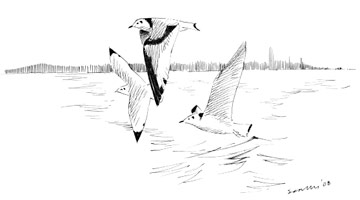Kittiwake (Rissa tridactyla)

Kittiwake © Ray Scally
This is the world’s most numerous species of gull and, in winter, is the most oceanic. Outside the breeding season, birds from all colonies and countries mix and spread across the whole of the north Atlantic, from Europe to north America, south to about 30ºN (Migration Atlas). Apart from those that latch on to fishing vessels, they probably feed mainly on planktonic marine invertebrates and often forage by flying daintily just above the water’s surface. A few winter birds are visible from shore in Britain, but less than 1% of the total that comes here to breed (BTO Winter Atlas). They are usually seen in Cheshire and Wirral during or after gales; this winter Atlas map depicts their typical distribution.
Birds were reported from Hilbre in all three winters, with submitted counts of 5, 2 and 20 birds but all of the other Kittiwake records came in two periods of extreme weather. The only large numbers were in November 2004 off Hoylake, when a flock of Kittiwakes was feeding offshore after big gales and counts were made of 100 in SJ28E and 1,250 in SJ29A; this was the same period as the largest flocks of Guillemots and Little Gulls. The other extremely windy spell, in November/ December 2006, brought the only inland record during this Atlas, a first winter bird on Hurleston Reservoir (SJ65H) on 25 November 2006. Another Kittiwake was not quite on the shore, roosting amongst other gulls on a field at Hoylake Langfields (SJ28J) on 11 December 2006, at the end of the same series of gales, and birds were seen in the other four tetrads off the north Wirral coast during the same spell that also affected several pelagic seabirds (Manx Shearwater, Leach’s Petrel, Great Skua).
The early ornithological literature is confusing about the winter status of Kittiwake in the county. In part this is probably because some birds have changed their habits – some returning in midwinter to breeding colonies from the 1960s onwards (BTO Winter Atlas) – but probably derives from the sporadic nature of study of the county’s seabirds, allied to Kittiwakes’ irregular occurrence. Records from 1957-1977 for the one site with systematic records of seawatching, Hilbre Island, show that the period from November to March is by far the quietest of the year for this species (Craggs 1982). As with some other seabirds, published reports overemphasise the occasional storm-driven inland birds. Kittiwakes do not willingly venture away from the sea and those found inland are probably weak or ill; they are seldom able to feed adequately on freshwater and have to return to the coast or die (BTO Winter Atlas).
In the last forty years the county bird reports indicate presence of birds in the mouth of the Dee each winter, but only irregularly in the Mersey. Large flocks, typically up to 200 birds, are found on average every few years, always connected to unusual weather.
In memory of Gail Bunker

